
Solar Energy Resource Potentials of the City of Arkadag
Energy Systems受け取った 08 Nov 2023 受け入れられた 21 Nov 2023 オンラインで公開された 22 Nov 2023
ISSN: 2995-8067 | Quick Google Scholar
Next Full Text
A Comprehensive Methodology for Assessing the Business Reputation of Industrial and Production Personnel


受け取った 08 Nov 2023 受け入れられた 21 Nov 2023 オンラインで公開された 22 Nov 2023
The article obtained systematized, scientifically substantiated gross, technical, economic, and environmental energy resource potentials from the introduction and use of solar energy technologies. The technical, economic, and environmental priorities of power plants were assessed in terms of energy efficiency, fuel economy, and the environmental impact per square meter from conversion to thermal and electrical energy in the city of Arkadag.
The calculated results are, kWh/m2 per year: gross resource potential of solar energy - 1844.6; the technical potential for conversion into thermal and electrical energy is equal to - 1256.44 and 242.44; economic - 502.6 and 96.98 kg fuel equivalent/m2 per year; environmental reduction in emissions of various harmful substances into the environment when using solar photovoltaic modules in the city of Arkadag will be: with annual electricity generation per m2 - 242.44 kW·h, annual fuel consumption savings - 96.96 kg. e., the reduction in emissions will be, kg per year: SO2 – 2.0; NOx – 1.1; CO – 0.14; CH4 – 0.29; CO2 – 155.0; solids – 0.21; when converted into thermal energy per m2 and annual production of 1256.4 kW·h, annual fuel savings are 502.6 kg of fuel equivalent; emission reduction will be, kg per year: SO2 – 10.4; NOx – 5.6; CO – 0.73; CH4 – 1.53; CO2 – 803.5; solids – 1.1.
Empirical equations (1-5) have been obtained taking into account the gross, technical, economic, and environmental resource potentials of solar energy in the city of Arkadag, it is possible to carry out energy and environmental forecasting when drawing up a feasibility study.
The idea of building a “smart city” Arkadag belongs to the Leader of the Nation Gurbanguly Berdimuhamedov, it provides for the use of information and communication automated control systems: water supply and energy supply; waste – smart waste; ensuring the mobility of citizens within the city - increasing the efficiency of road use by both personal and public transport, introducing smart transport and smart parking; digitalization and ensuring reliable communications – creating an environment for easy interconnection and exchange of information between citizens; citizen participation in city management – e-government; safe city – ensuring the safety of citizens; accessible e-education and healthcare – smart healthcare, telemedicine, distance learning; environmental protection – control of pollution and noise levels, creation and use of “green” technologies [-].
The first “smart” city of Turkmenistan will be equipped with a scaled LoRaWAN (Long Range Wide Area Network), which is an energy-efficient long-distance data transmitter and is characterized by high operating autonomy in a large network area. Electricity, drinking water, and natural gas sensors are installed in the overall LoRaWAN system, which will facilitate the reception of signal data at a distance of 10-15 km via the Ethernet network (a family of technologies for packet data transfer between devices). The basic LoRaWAN system will be able to listen to the air in a given frequency range, send a request from any of the devices, and respond to it at the same frequency. At the same time, the channel width is 125 kHz with a maximum speed of more than 5 kilobits/s. Thus, the device can turn on motion sensors, open and close doors, control the temperature and humidity conditions of the building, monitor water leakage, turn on and off electrical appliances, and remotely control home systems using digital information technologies [].
Communication will be carried out using the most modern technological system GPON (Gigabit Passive Optical Network), which is a high-speed passive optical network that allows you to simultaneously use the Internet, digital television, and IP telephone network on one cable with a speed of 1 Gigabit per second. With the introduction of GPON technology, the city of Arkadag will become the first city in the Central Asian region where this modern communication technology will be installed [].
In order to preserve the natural purity and beauty in the territory of the sunny “smart city”, Arkadag should be an exemplary educational cultural center, energy and environmentally friendly using “green” technologies; “green” technology means the use of renewable energy sources (RES), in a “smart city” » the resource potential of solar energy will be used.
In Turkmenistan, a lot of work has been done on the use of solar energy in the last century and certain scientific and practical results have been obtained. However, there is an unimproved systematic scientific analysis; the resource energy potential of the country’s regions has not been assessed. Using the new methodology, the gross, technical, economic, and environmental resource potentials for the introduction and use of energy-efficient technologies and installations based on solar radiation in the Ahal velayat (region) of Turkmenistan, which has significant resources, have not been identified [,].
The results obtained by the authors will fill this gap and will contribute to the preparation of a feasibility study (TES) for the introduction and use of solar energy technologies that will help save energy resources, improve the socio-economic and environmental conditions of the city, and reduce the anthropogenic load on the biosphere due to climate change. Taking into account the results of the literature review on the use of solar energy, the goals and objectives of scientific research on the use of the resource potential of the Sun in the infrastructure of a modern city of a new generation - Arkadag - have been set.
The purpose and objectives of the research work are to scientifically substantiate, systematize, and calculate solar energy resource potentials, evaluate the technical, economic, and environmental characteristics of energy installations in terms of energy efficiency, fuel economy for the development, creation, implementation, and use of solar energy technologies in solar infrastructure cities.
The methodology and research methods are based on a systematic approach to engineering objects as an integral complex of theoretical, practical, and experimental work using solar energy technologies in the city of Arkadag.
The methodological basis consists of calculations based on a mathematical model of thermal parameters of engineering structures, obtained empirical expressions of solar resource potentials for the introduction and use of energy technologies in a modern city, taking into account natural and climatic conditions.
The scientific novelty of the research is that the gross, technical, economic, and environmental resource potentials for the preparation of a feasibility study, implementation, and use of solar energy technological installations in the infrastructure of the city of Arkadag are systematized, scientifically substantiated, calculated, and assessed.
The general nature of solar radiation on the territory of Turkmenistan is determined by its geographical location in Central Asia. A distinctive feature of the territory is its location in the interior of the continent and the absence of extensive water bodies. All this determines the overall aridity of the climate and the lack of precipitation during the long summer period. The average annual air temperature of the city of Arkadag varies from 11 °C -
13 °C. The coldest month is January, its average temperature varies from –6 °C to +3 °C, the average temperature of the hottest month – July – is + 27.0 °C - 32.4 °C. The absolute maximum reaches +50.1 °C. The greatest amount of precipitation in the territory is 150 mm. As a result, soil drought and thermal depression develop in the city, characterized by a cloudless sky, high solar radiation activity, and air temperature with dusty haze. With a clear sky, the solar radiation arrival is 1844.6 kWh/m2 per year, this is due to the transparency of the atmosphere and the aridity of the city. The results of analytical calculations for the city showed: that the duration of sunshine is 2680 hours; dark time is 6080 hours per year; the average number of daylight hours is 8.4 hours per year; the average sunrise time – is 6.5 hours per year; average sunset is 17.25 hours [,,].
The research methodology was based on the location of the sunny city of Arkadag - 38o04´17´´N, 58o03´56´´E. The calculations took into account the natural and climatic conditions of the area: duration of sunshine by month of the year; average annual temperature conditions of the area and productivity of the solar installation; the receipt of direct and scattered radiation of solar energy, surface albedo, angular parameters of solar radiation on inclined and normal surfaces throughout the year by month; the angle of movement of the solar declination and the inclination of the surface to the horizon by the hour; specific energy characteristics of solar installations [,,].
The sum of the arrival of direct and scattered radiation from the Sun is called the gross potential. The gross potential of solar energy was determined depending on the volume and nature of the information; the calculation of the gross potential of solar energy in the city is carried out according to the following two options: in the location area and in the absence of a weather station.
In the area where the meteorological station is located, the arrival of direct and diffuse solar energy, and long-term average data are summarized for each month throughout the year and entered into a table.
In the area where there is no meteorological station, weather data from neighboring stations are used to determine the arrival of solar energy. When making calculations, it is necessary to calculate the average values of the duration of the arrival of solar energy, which can be found using the given formula [,,,].
Taking into account the above natural-climatic and hydrometeorological conditions, scientifically grounded theoretical, practical, and methodological calculations and generalized systematized results of solar energy potential for the use of power plants in the city of Arkadag were obtained. The following calculated results were assessed: the arrival of solar radiation on a horizontal surface during the year by month, kWh/m2 per month; duration of sunshine during the year by month, hours/month; average annual temperature of the area during the day (operating time of solar installations throughout the year), °C; the arrival of scattered and direct radiation depending on the angle of inclination and the normally oriented surface of the technological installation by month of the year, degree; surface albedo, %; angle of movement of the sun and solar declination, degrees; the angle of inclination of the surface to the horizon is taken into account; specific energy characteristics of a solar installation, kWh/m2 per month; gross potential of solar radiation, kWh/m2 per month; specific technical potential of thermal and electrical energy from solar radiation by month of the year, kWh/m2 per month; specific volume of thermal and electrical energy production per unit area of a solar power installation by month of the year, kWh/m2 per month [,].
Taking into account the hydrometeorological data of the city of Arkadag, the annual arrival of direct solar radiation on the horizontal surface, the gross potential under clear skies is 1844.6 kWh/m2 per year. Slight lower cloudiness reduces the input of direct solar radiation by only 27% - 35% of the possible amount and at the same time increases diffuse radiation by 25% - 40%. As a result, under real cloudy conditions, the annual arrival of total radiation is reduced compared to the possible one by 13 - 19% [,,,,].
The technical potential of a city’s solar radiation is the long-term average total energy that can be obtained from solar radiation within one year at the current level of development of innovative technologies and compliance with the city’s environmental standards.
The technical potential of solar radiation represents the sum of technical potentials converted into thermal and electrical energy [,,].
The methodology for determining the technical potential of thermal energy and electrical energy converted from solar radiation is given in the works [,,].
Based on the calculation results, a histogram of the technical potential converted into thermal and electrical energy was constructed, which is shown in Figure 1.
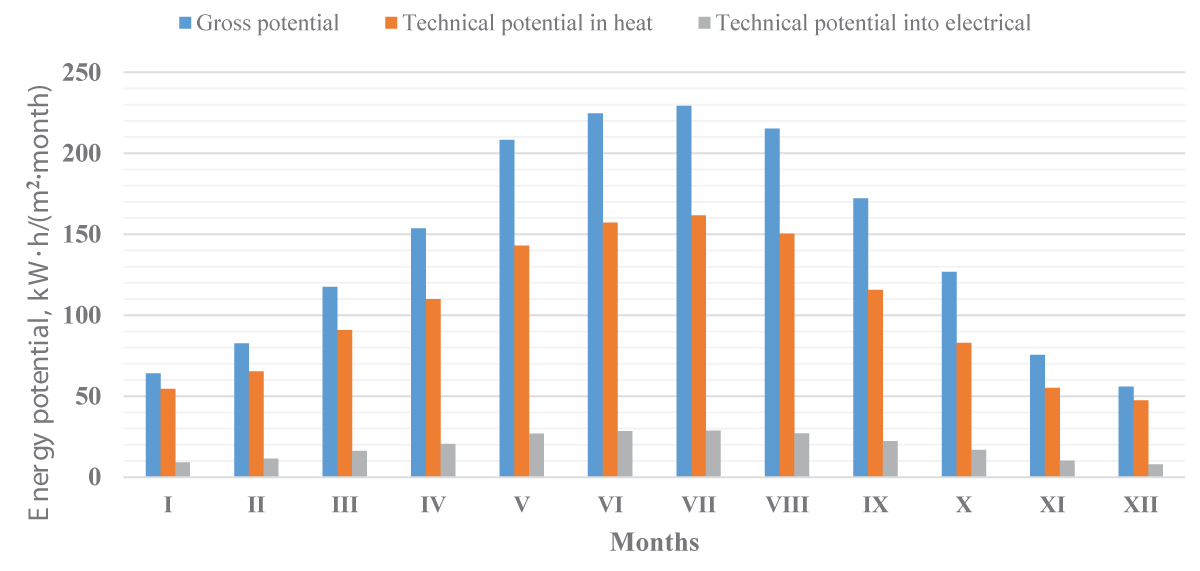 Figure 1: Distribution of the gross and technical potential of solar energy from conversion into thermal and electrical energy in the city of Arkadag by month per 1 square meter during the year.
Figure 1: Distribution of the gross and technical potential of solar energy from conversion into thermal and electrical energy in the city of Arkadag by month per 1 square meter during the year.The economic potential of solar energy in the city of Arkadag is the production of thermal and electrical energy in the region from solar radiation, which is economically justified for the region at the existing price level for energy received from traditional sources, taking into account and compliance with environmental standards [,,].
The ecological potential of solar energy represents the sum of the economic potentials of thermal energy and electrical energy obtained by the corresponding transformation of solar radiation.
The economic potential of solar energy represents the sum of the economic potentials of its constituent zones. The average specific production of energy parameters in solar thermal and photovoltaic installations in the city of Arkadag by month during the year is shown in Figure 2.
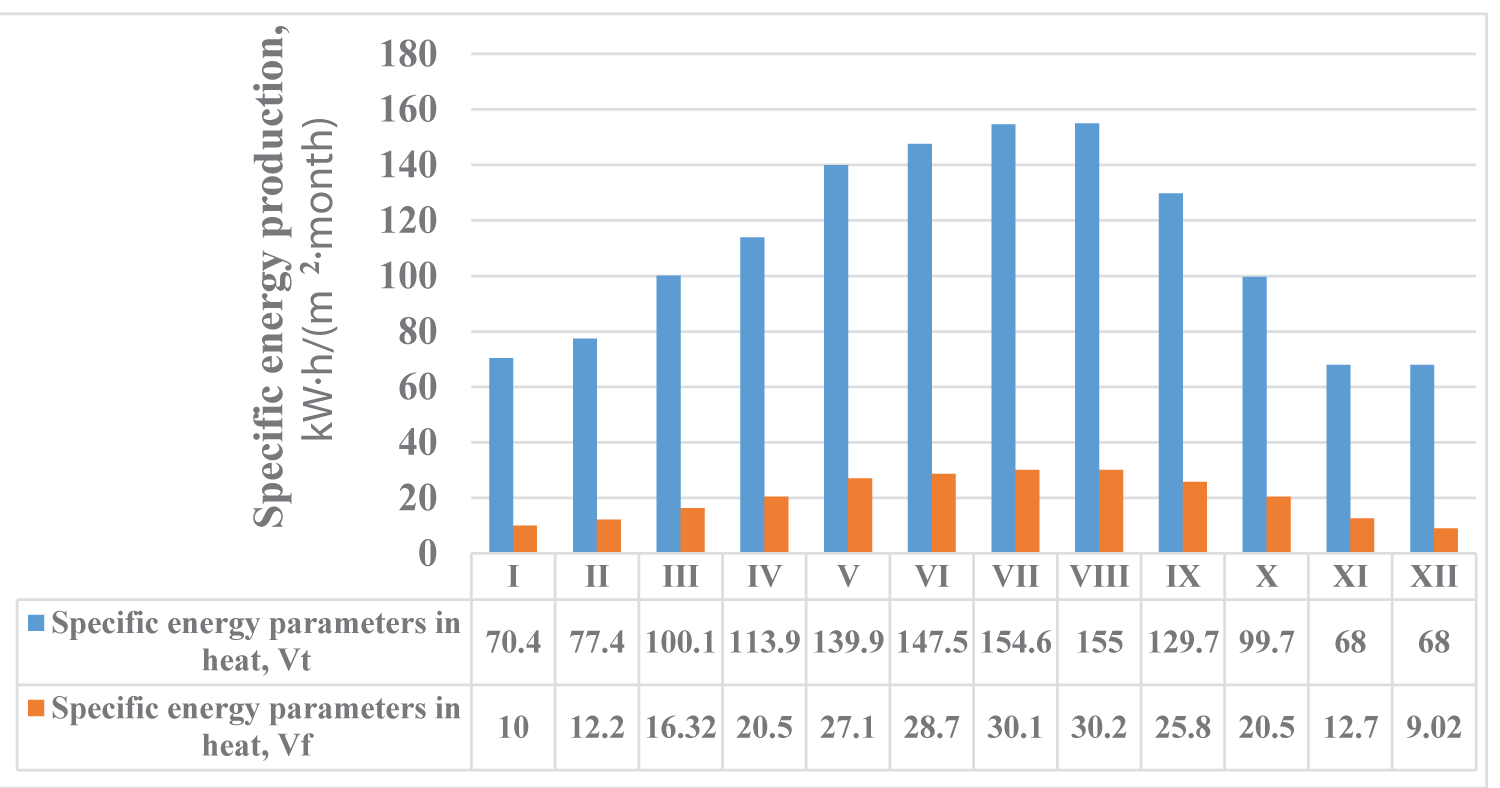 Figure 2: The average specific production of energy parameters in solar thermal Vt, photovoltaic Vf installations in the city of Arkadag by month during the year.
Figure 2: The average specific production of energy parameters in solar thermal Vt, photovoltaic Vf installations in the city of Arkadag by month during the year.The environmental potential is part of the technical potential, the conversion of which into useful usable energy is environmentally feasible at a given level of reduction of harmful emissions into the environment from fossil organic fuels when converted into thermal, electrical, and other types of energy from equipment, installations, stations and vehicles, etc. pollutants [,,].
The expressions defining economic efficiency do not take into account the impact of the introduced installations on the environment and on the social conditions of human life and activity. Renewable energy sources, compared to traditional ones, have an important advantage in the ability to ensure the environmental cleanliness of installed installations, and in some cases, the possibility of improving the environmental situation [,,].
The ecological potential of solar energy represents the sum of the economic potentials of thermal energy and electrical energy obtained by converting solar radiation.
One form of taking into account the impact of input energy sources on the ecology of a region can be the introduction of a regional environmental factor of the source into the unit cost of energy received, taking into account the relative costs of compensating for the harmful consequences of introducing a unit of energy from a particular source in the region. If the specific cost of an energy source in production is known, then the specific cost taking into account the coefficient of the regional environmental factor > 1 for a source leading to deterioration of the environmental situation in the region, and the coefficient of the regional environmental factor < 1 for a source that improves the environmental situation in the region; for the same source, the environmental coefficient in different regions can change in value, become more or less than one [,,].
The expected results of the environmental potential from converted solar energy into thermal and electrical energy in conventional units per square meter are shown in Figure 3.
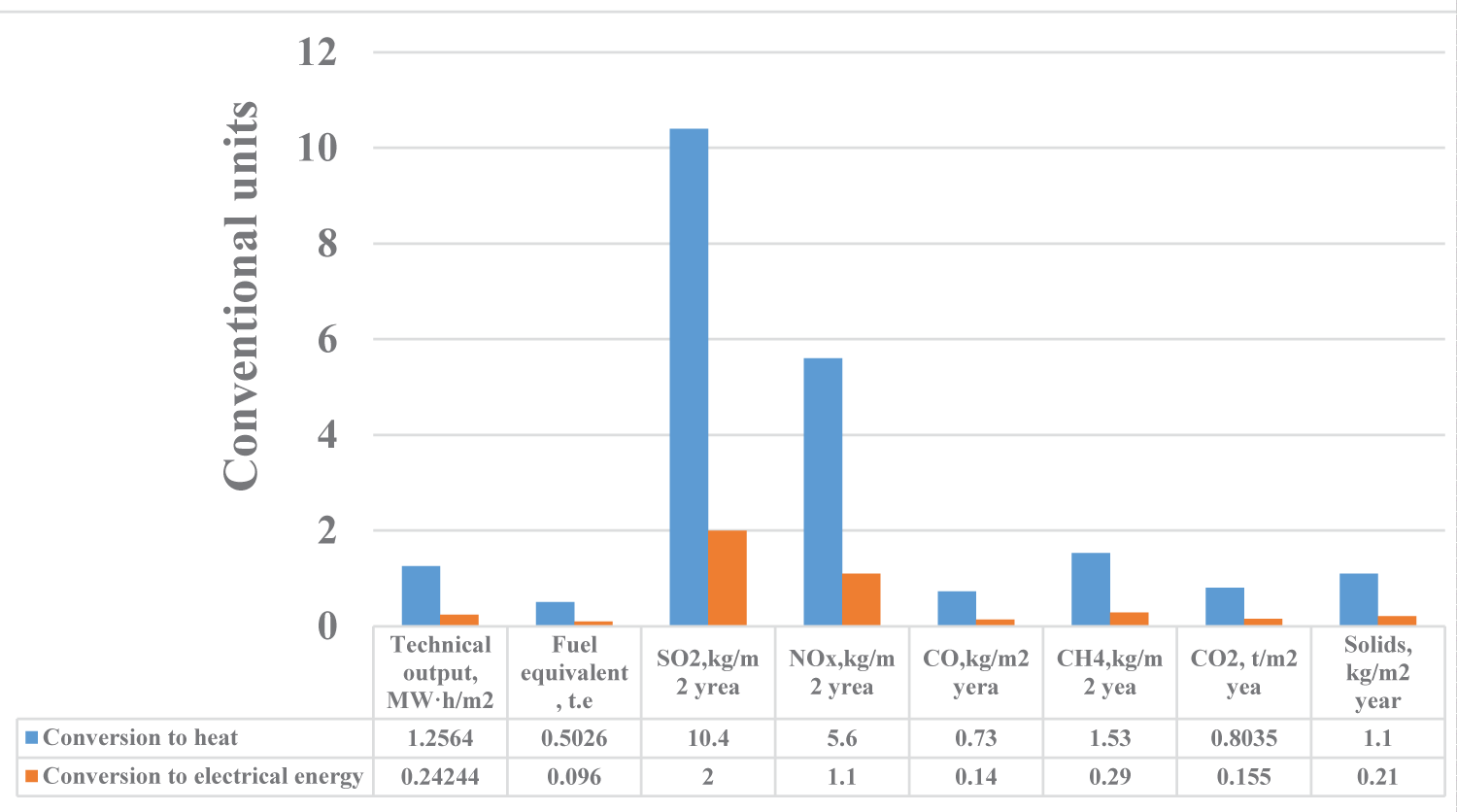 Figure 3: Expected environmental indicators for the reduction of harmful substances into the biosphere of the city of Arkadag from the conversion of solar energy into heat and electricity during the year.
Figure 3: Expected environmental indicators for the reduction of harmful substances into the biosphere of the city of Arkadag from the conversion of solar energy into heat and electricity during the year.As a result of scientific research, scientifically based and theoretically systematized principles for the use of solar energy resource potentials using a formalized methodology were obtained, and the potential and volume of reducing anthropogenic loads on the environment from the use of solar energy installations during conversion into thermal and electrical energy were determined.
The estimated estimated results in the city of Arkadag are:
The gross resource potential of solar energy is 1844.6 kWh/m2 per year;
The technical potential for conversion into thermal and electrical energy is equal to 1256.44 and 242.44 kWh/m2 per year.
Economic potentials from conversion into thermal and electrical energy in the city are: 502.6 and 96.98; in kg equivalent fuel/m2 per year:
Expected environmental potential: reduction in emissions of various harmful substances into the environment when using solar photovoltaic modules will be:
- With annual electricity generation per square meter - of 242.44 kWh, and annual fuel consumption savings - of 96.96 kg of fuel equivalent. , the reduction in emissions will be, kg per year: SO2 – 2.0; NOx – 1.1; CO – 0.14; CH4 – 0.29; CO2 – 155.0; solids – 0.21;
- When converted into thermal energy from one square meter and an annual production of 1256.4 kW⋅h, the annual fuel economy is 502.6 kg of fuel equivalent; emission reduction will be, kg per year: SO2 – 10.4; NOx – 5.6; CO – 0.73; CH4 – 1.53; CO2 – 803.5; solids – 1.1.
Taking into account the obtained calculations of gross, technical, economic, and environmental potentials, the use of solar energy installations is an effective, affordable means of energy saving and ensuring environmental safety [,].
Mathematical methods also make it possible to systematize and classify research results; on their basis, develop, and create for the implementation of solar energy installations and carry out zoning. Determine the similarities and differences between interaction processes in various natural conditions, and the probabilistic dependence between atmospheric phenomena, highlighting the main factors when predicting a feasibility study on the feasibility of using solar energy technologies.
Correlation analysis is used to study the relationship between two random variables. The Pearson correlation coefficient, R2, is used as the strength of this relationship. As a correlation analysis, we examined the dependence of gross, technical, energy potentials on the average long-term solar radiation by month during the year in the city of Arkadag (see below the found values of R2, which indicate the accuracy of calculations of two functional quantities of solar radiation depending on the transformation into thermal and electrical energy). The mathematical relationship is expressed by regression coefficients; we derive the regression equation in the form y = a+bx, where a is the initial ordinate and gives the value of y at x = 0, b is a regression coefficient showing how much the value of y will change on average if x changes by one [,,,].
In our calculations, the potentials of solar radiation depend on the conversion into thermal and electrical energy, the equations have the form:
Gross y = - 0.3332x + 160.19, R² = 0.0003; (1)
Technical to thermal: y = -0.7073x + 112.64, R² = 0.0027; (2)
Technical to electrical: y = -0.0787x + 21.22; R² = 0.001; (3)
Specific energy parameters of solar thermal, Vt: y = -0.1797x + 116.02, R² = 0.0002; (4)
Specific energy parameters of solar photovoltaic, Vf : y = 0.1594 x + 21.38; R² = 0.0042. (5)
Thus, the obtained regression equations of technical potential and specific energy parameters of solar radiation converted into thermal and electrical energy will contribute to the forecasting of various solar energy technological installations, as well as in the preparation of design estimates and feasibility studies for construction in the city of Arkadag.
Based on the study, the following were obtained: systematized, scientifically based gross energy, technical, economic, and environmental solar resource potentials from the introduction of solar energy technologies; The technical, economic, and environmental characteristics of power plants were assessed in terms of energy efficiency, fuel economy, and environmental impact for the city of Arkadag per square meter of conversion into thermal and electrical energy.
As a result, empirical equations were obtained taking into account the gross, technical, and environmental potentials of solar energy in the city of Arkadag, with the help of which energy and environmental forecasting can be carried out. The results obtained will help predict the possibilities of saving electricity and reducing CO2 emissions per square meter in grams of CO2 equivalent when converting solar energy into electrical energy, as well as calculate the energy potential of solar power plants, equipment, and structures in a modern city of the 21st century.
Berdimuhamedov GM. Electric power power of Turkmenistan - Ashgabat: Turkmen State Publishing Service. 2022;
What is LoRaWan. https://habr.com/ru/company/nag/blog/371067/
GPON technology: What is it and how to connect? https://internet.gde-luchshe.ru/help/tehnologiya-gpon-chto-eto-i-kak-podklyuchitsya/
Strebkov DS, Penjiyev AM, Mamedsakhatov BD. Development of solar energy in Turkmenistan: Monograph. M.: GNU VIESKh, 2012; 498.
Bezrukikh PP, Arbuzov YuD, Borisov GA, Vissarionov VI, Evdokimov VM, Malinin NK, Ogorodov NV, Puzakov VN, Sidorenko GI, Shpak AA. Resources and efficiency of using renewable energy sources in Russia. St. Petersburg: Nauka, 2002; 314.
Vissarionov VI, Deryugina GV, Kuznetsova VA, Malinin NK. Solar energy:textbook for universities . M.: MPEI Publishing House. 2008; 276.
Strebkov DS. Solar Energy Basics. Ed. PP Bezrukih. M: SAM Polygraphist. 2019; 326.
Duffy DA, Beckman WA. Thermal processes using solar energy. M: Mir. 1977; 429.
Penjiyev AM. Agricultural technology for growing melon trees in protected soil conditions: monograph. Moscow: RUSAINS. 2018;
Penjiyev AM. Eco-energy resources of renewable energy sources: monograph. Moscow: RUSAINS. 2023;
Penjiyev AM. Thermal Regim in Combined Cultivation Constructions. Applied Solar Energy. 2018; 54: 200-208.
Strebkov DS, Penjiyev AM. Solar power plants with parabolic trough concentrators in the desert area of Karakum. Applied Solar Energy. 2019; 55: 195-206.
Kondratyev KYa, Pivovarova ZI. Radiation regime of inclined surfaces. L.: Gidrometeoizdat. 1978; 215.
Penjiyev AM. Fundamentals of GIS in the development of renewable energy. Germany: LAP LAMBERT Academic Publishing. 2017; 308.
Scientific and applied reference book on the climate of the USSR. Episode 3, parts 1-16. – L.: Hydromethioizdate, 1989; 502.
USSR Climate Handbook. Turkmen SSR, part 1. Solar radiation and radiation balance for individual years. Tashkent: 1974; 30: 98.
Arbuzov YuD, Evdokimov VM, Levinskas AL. Development of photovoltaic modules with parabolic concentrators and silicon photoconverters. T Solar Engineering. 1996; 3-10.
Gorodnichev RM, Pestryakova LA, Ushnitskaya LA, Levina SN, Davydova PV.Methods of environmental research. Fundamentals of statistical data processing: Educational and methodological manual. Yakutsk: NEFU Publishing House, 2019. 94.
Penjiyev AM. Prospects for alternative energy and its environmental potential in Turkmenistan. Sarov: Alternative Energy and Ecology. 2009; 9(77). 131-139.
Berdimuhamedov GM. Turkmenistan is on the path to achieving sustainable development goals. Ashgabat: Turkmen State Publishing Service. 2018; 468.
Use of solar energy. Under general ed. LE Rybakova. – Ashgabat: Science. 1985; 280.
Myradovich PE, Orazmuhamedovich OR. Solar Energy Resource Potentials of the City of Arkadag. IgMin Res. Nov 22, 2023; 1(1): 076-080. IgMin ID: igmin119; DOI: 10.61927/igmin119; Available at: www.igminresearch.com/articles/pdf/igmin119.pdf
次のリンクを共有した人は、このコンテンツを読むことができます:
Address Correspondence:
Penjiyev Ahmet Myradovich, Turkmen State Institute of Architecture and Civil Engineering, Turkmenistan, Email: [email protected]
How to cite this article:
Myradovich PE, Orazmuhamedovich OR. Solar Energy Resource Potentials of the City of Arkadag. IgMin Res. Nov 22, 2023; 1(1): 076-080. IgMin ID: igmin119; DOI: 10.61927/igmin119; Available at: www.igminresearch.com/articles/pdf/igmin119.pdf
Copyright: © 2023 Myradovich PA, et al. This is an open access article distributed under the Creative Commons Attribution License, which permits unrestricted use, distribution, and reproduction in any medium, provided the original work is properly cited.
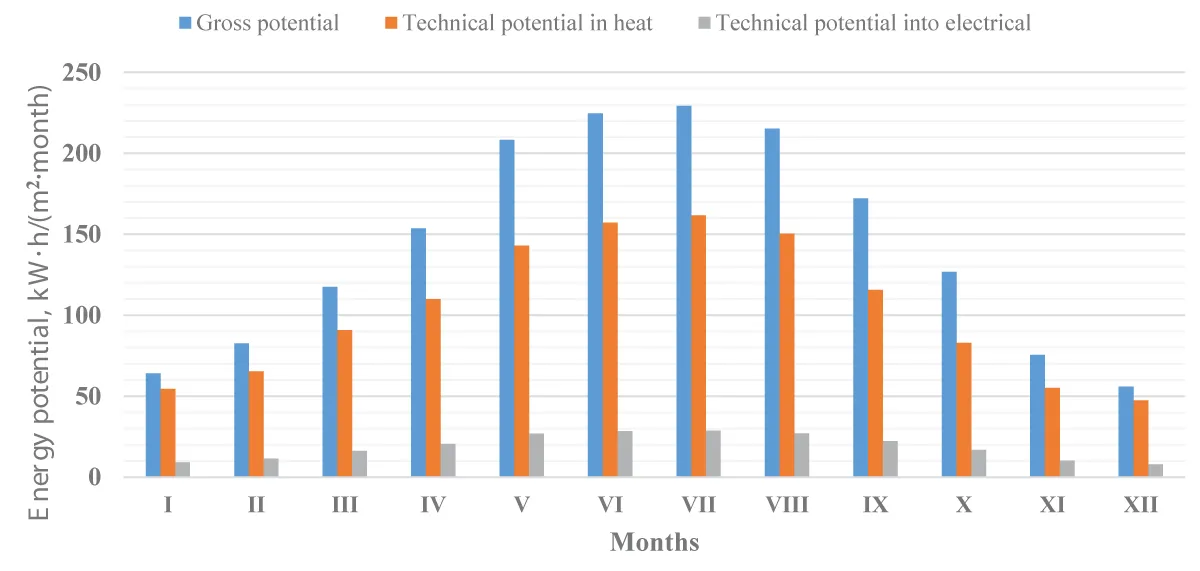 Figure 1: Distribution of the gross and technical potential ...
Figure 1: Distribution of the gross and technical potential ...
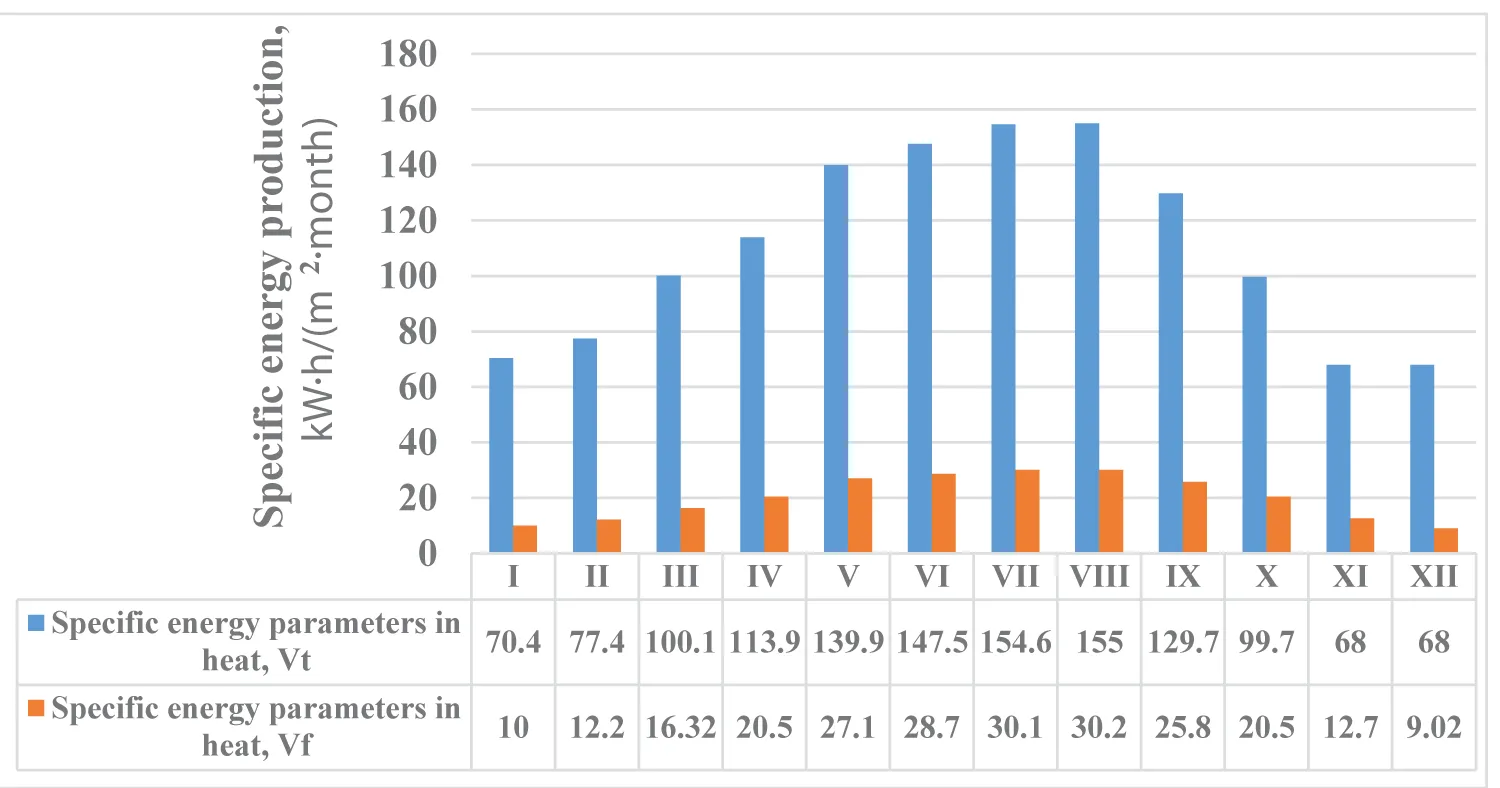 Figure 2: The average specific production of energy paramete...
Figure 2: The average specific production of energy paramete...
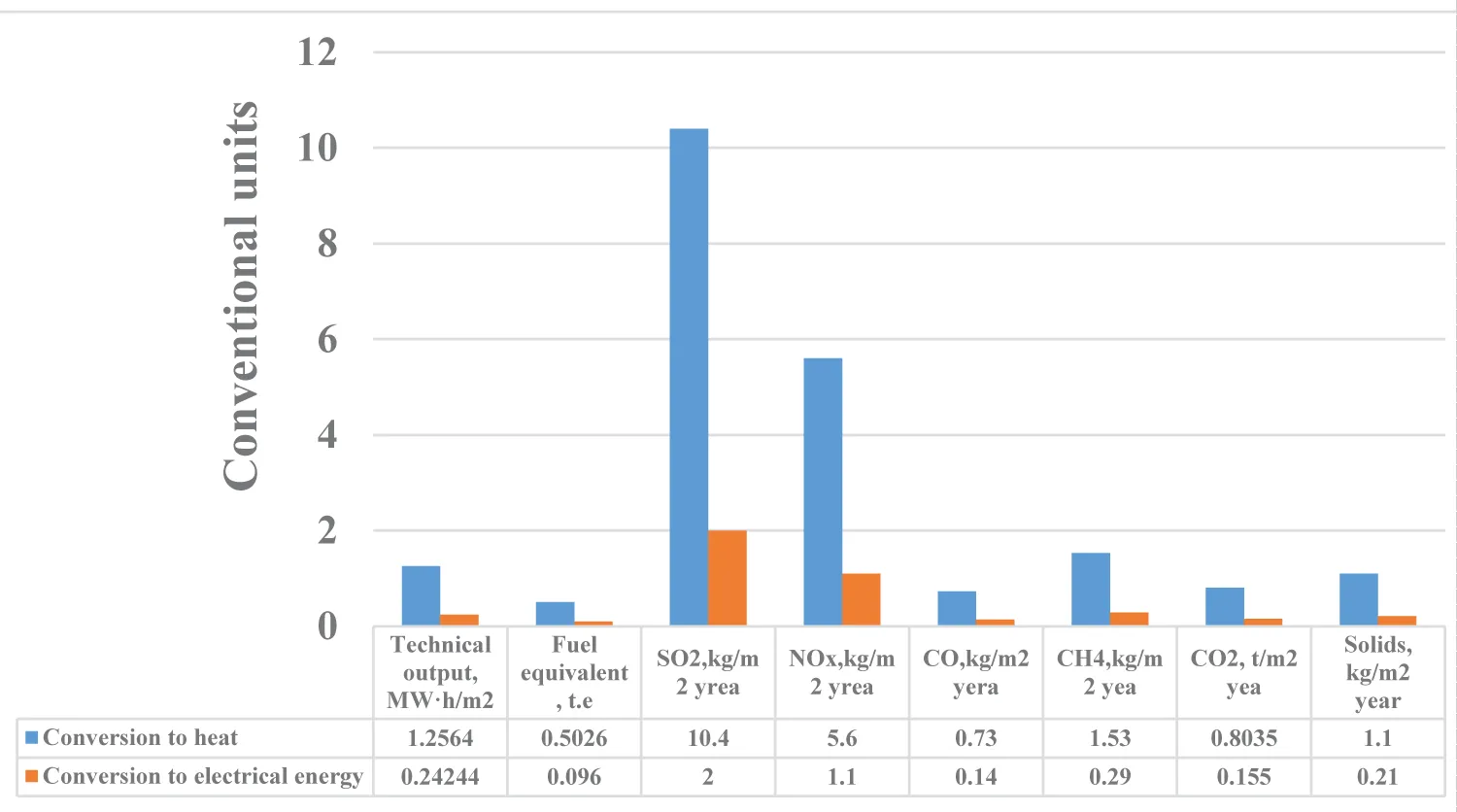 Figure 3: Expected environmental indicators for the reductio...
Figure 3: Expected environmental indicators for the reductio...
Berdimuhamedov GM. Electric power power of Turkmenistan - Ashgabat: Turkmen State Publishing Service. 2022;
What is LoRaWan. https://habr.com/ru/company/nag/blog/371067/
GPON technology: What is it and how to connect? https://internet.gde-luchshe.ru/help/tehnologiya-gpon-chto-eto-i-kak-podklyuchitsya/
Strebkov DS, Penjiyev AM, Mamedsakhatov BD. Development of solar energy in Turkmenistan: Monograph. M.: GNU VIESKh, 2012; 498.
Bezrukikh PP, Arbuzov YuD, Borisov GA, Vissarionov VI, Evdokimov VM, Malinin NK, Ogorodov NV, Puzakov VN, Sidorenko GI, Shpak AA. Resources and efficiency of using renewable energy sources in Russia. St. Petersburg: Nauka, 2002; 314.
Vissarionov VI, Deryugina GV, Kuznetsova VA, Malinin NK. Solar energy:textbook for universities . M.: MPEI Publishing House. 2008; 276.
Strebkov DS. Solar Energy Basics. Ed. PP Bezrukih. M: SAM Polygraphist. 2019; 326.
Duffy DA, Beckman WA. Thermal processes using solar energy. M: Mir. 1977; 429.
Penjiyev AM. Agricultural technology for growing melon trees in protected soil conditions: monograph. Moscow: RUSAINS. 2018;
Penjiyev AM. Eco-energy resources of renewable energy sources: monograph. Moscow: RUSAINS. 2023;
Penjiyev AM. Thermal Regim in Combined Cultivation Constructions. Applied Solar Energy. 2018; 54: 200-208.
Strebkov DS, Penjiyev AM. Solar power plants with parabolic trough concentrators in the desert area of Karakum. Applied Solar Energy. 2019; 55: 195-206.
Kondratyev KYa, Pivovarova ZI. Radiation regime of inclined surfaces. L.: Gidrometeoizdat. 1978; 215.
Penjiyev AM. Fundamentals of GIS in the development of renewable energy. Germany: LAP LAMBERT Academic Publishing. 2017; 308.
Scientific and applied reference book on the climate of the USSR. Episode 3, parts 1-16. – L.: Hydromethioizdate, 1989; 502.
USSR Climate Handbook. Turkmen SSR, part 1. Solar radiation and radiation balance for individual years. Tashkent: 1974; 30: 98.
Arbuzov YuD, Evdokimov VM, Levinskas AL. Development of photovoltaic modules with parabolic concentrators and silicon photoconverters. T Solar Engineering. 1996; 3-10.
Gorodnichev RM, Pestryakova LA, Ushnitskaya LA, Levina SN, Davydova PV.Methods of environmental research. Fundamentals of statistical data processing: Educational and methodological manual. Yakutsk: NEFU Publishing House, 2019. 94.
Penjiyev AM. Prospects for alternative energy and its environmental potential in Turkmenistan. Sarov: Alternative Energy and Ecology. 2009; 9(77). 131-139.
Berdimuhamedov GM. Turkmenistan is on the path to achieving sustainable development goals. Ashgabat: Turkmen State Publishing Service. 2018; 468.
Use of solar energy. Under general ed. LE Rybakova. – Ashgabat: Science. 1985; 280.